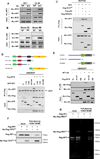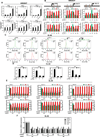WT1 recruits TET2 to regulate its target gene expression and suppress leukemia cell proliferation
- PMID: 25601757
- PMCID: PMC4336627
- DOI: 10.1016/j.molcel.2014.12.023
WT1 recruits TET2 to regulate its target gene expression and suppress leukemia cell proliferation
Abstract
The TET2 DNA dioxygenase regulates cell identity and suppresses tumorigenesis by modulating DNA methylation and expression of a large number of genes. How TET2, like most other chromatin-modifying enzymes, is recruited to specific genomic sites is unknown. Here we report that WT1, a sequence-specific transcription factor, is mutated in a mutually exclusive manner with TET2, IDH1, and IDH2 in acute myeloid leukemia (AML). WT1 physically interacts with and recruits TET2 to its target genes to activate their expression. The interaction between WT1 and TET2 is disrupted by multiple AML-derived TET2 mutations. TET2 suppresses leukemia cell proliferation and colony formation in a manner dependent on WT1. These results provide a mechanism for targeting TET2 to a specific DNA sequence in the genome. Our results also provide an explanation for the mutual exclusivity of WT1 and TET2 mutations in AML, and suggest an IDH1/2-TET2-WT1 pathway in suppressing AML.
Copyright © 2015 Elsevier Inc. All rights reserved.
Figures






Comment in
-
A new path to leukemia with WIT.Mol Cell. 2015 Feb 19;57(4):573-574. doi: 10.1016/j.molcel.2015.02.005. Mol Cell. 2015. PMID: 25699704
Similar articles
-
DNA hydroxymethylation profiling reveals that WT1 mutations result in loss of TET2 function in acute myeloid leukemia.Cell Rep. 2014 Dec 11;9(5):1841-1855. doi: 10.1016/j.celrep.2014.11.004. Epub 2014 Dec 4. Cell Rep. 2014. PMID: 25482556 Free PMC article.
-
TET2/IDH1/2/WT1 and NPM1 Mutations Influence the RUNX1 Expression Correlations in Acute Myeloid Leukemia.Medicina (Kaunas). 2020 Nov 24;56(12):637. doi: 10.3390/medicina56120637. Medicina (Kaunas). 2020. PMID: 33255417 Free PMC article.
-
A new path to leukemia with WIT.Mol Cell. 2015 Feb 19;57(4):573-574. doi: 10.1016/j.molcel.2015.02.005. Mol Cell. 2015. PMID: 25699704
-
Role of DNMT3A, TET2, and IDH1/2 mutations in pre-leukemic stem cells in acute myeloid leukemia.Int J Hematol. 2013 Dec;98(6):648-57. doi: 10.1007/s12185-013-1407-8. Epub 2013 Aug 15. Int J Hematol. 2013. PMID: 23949914 Free PMC article. Review.
-
Molecular pathogenesis of AML: translating insights to the clinic.Best Pract Res Clin Haematol. 2013 Sep;26(3):245-8. doi: 10.1016/j.beha.2013.10.003. Epub 2013 Oct 15. Best Pract Res Clin Haematol. 2013. PMID: 24309525 Free PMC article. Review.
Cited by
-
Structure and Function of TET Enzymes.Adv Exp Med Biol. 2022;1389:239-267. doi: 10.1007/978-3-031-11454-0_10. Adv Exp Med Biol. 2022. PMID: 36350513
-
Metabolism in Hematopoiesis and Its Malignancy.Adv Exp Med Biol. 2023;1442:45-64. doi: 10.1007/978-981-99-7471-9_4. Adv Exp Med Biol. 2023. PMID: 38228958
-
Imprinted genes in myeloid lineage commitment in normal and malignant hematopoiesis.Leukemia. 2015 Jun;29(6):1233-42. doi: 10.1038/leu.2015.47. Epub 2015 Feb 23. Leukemia. 2015. PMID: 25703588 Review.
-
Aberrant DNA hydroxymethylation reshapes transcription factor binding in myeloid neoplasms.Clin Epigenetics. 2022 Jun 28;14(1):81. doi: 10.1186/s13148-022-01297-5. Clin Epigenetics. 2022. PMID: 35765052 Free PMC article.
-
An evolutionary, or "Mitocentric" perspective on cellular function and disease.Redox Biol. 2020 Sep;36:101568. doi: 10.1016/j.redox.2020.101568. Epub 2020 May 26. Redox Biol. 2020. PMID: 32512469 Free PMC article. Review.
References
Publication types
MeSH terms
Substances
Grants and funding
LinkOut - more resources
Full Text Sources
Other Literature Sources
Medical
Molecular Biology Databases
Research Materials
Miscellaneous

